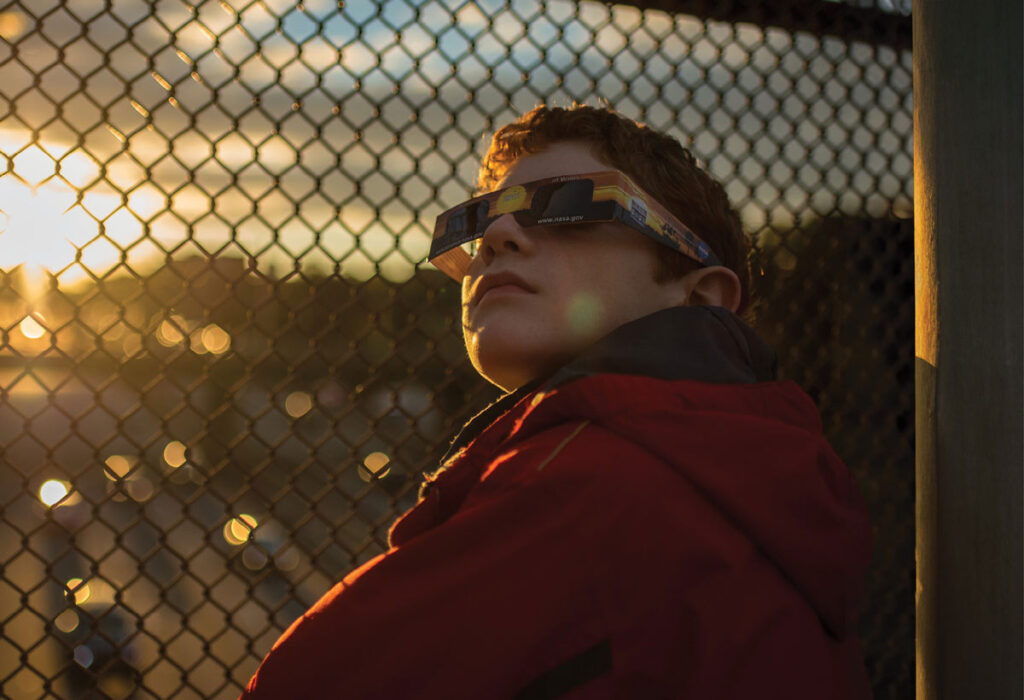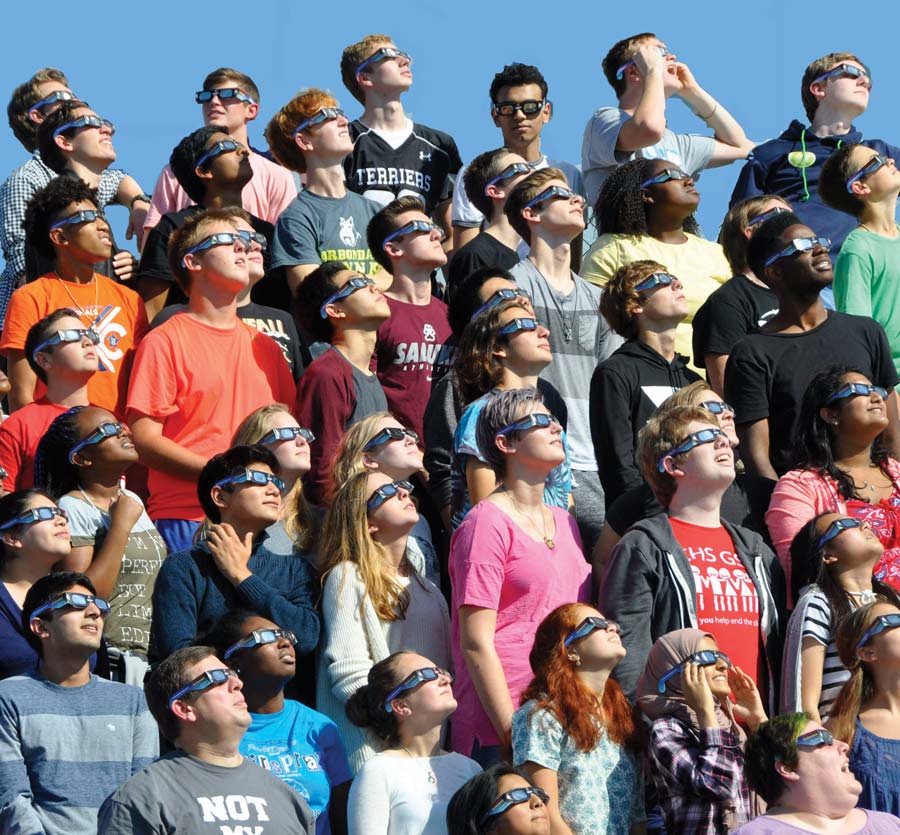
Astronomer Robert Strausbaugh has never seen a total eclipse in person, but the Eastern Illinois University (EIU) professor does not have to wait long to finally experience one. Nor will he have to travel to be in its path. Like millions of others in the U.S. and thousands in Illinois, he will find himself in the moon’s shadow during a total solar eclipse on the afternoon of April 8. Officially, the total solar eclipse in Illinois begins at 1:58 p.m., with the final exit of the moon’s shadow from the state at 2:06 p.m.
“The eclipse is going to pass through Texas up through New England in sort of a diagonal path,” the native of Arizona, who now works as an assistant professor of physics and director of the Charleston campus’ observatory, explains. “Most of the country will be able to see at least a partial eclipse.”
According to NASA, a total solar eclipse happens when the moon passes between the sun and Earth, casting a shadow on the planet. Places where the moon’s shadow covers the sun are known as the path of totality. The closer to the centerline of the path, the more complete the total eclipse will be, and the longer eclipse viewers in those areas will be in darkness. In Illinois, the centerline of the eclipse includes the communities of Murphysboro, Carbondale, West Frankfort, Benton and Fairfield.
The path of the total solar eclipse includes the towns of Metropolis and Cairo to the south, as well as Chester, Centralia, Salem, Effingham and Paris to the north. Although not in complete totality, about one-third of Illinois, and much of the nation, will experience the eclipse. At the EIU observatory, Strausbaugh says he expects “near totality.”

“Here, we’ll be at 99.5% totality, so we won’t quite be in the totality, but we’ll still see the dimming of the sun and the sun being covered by the moon, but it won’t be the same level of darkness,” he says.
“During the total eclipse, it will get pretty dark, similar to twilight levels of darkness and, from a biological point of view, any birds that you normally hear chirping during the day will be quiet,” Strausbaugh explains. “Between the darkening of the sky and the quiet of nature, it [should be] a surreal experience.” In fact, he adds, the skies will be dark enough that streetlights should come on.
The time of totality (darkness), slightly more than 4 minutes in some locations (4:06 in Benton, for example), helps Strausbaugh understand how ancient civilizations were mystified by these rare celestial events. “I imagine what it would have been like if I was an ancient human. Pretty much every other day of your life, the sun comes up in the morning and it goes down at night, then maybe once in your entire lifetime, during the middle of the day, the sun just goes away for potentially minutes at a time. How would you make sense of that?” He continues, “Obviously, with our current understanding of how the solar system works, we have figured it out, but back then, it must have been an indescribable experience.”
Even today, with knowledge of the why and when of total solar eclipse events, many still characterize them as indescribable experiences. For that reason, statewide tourism officials expect travelers not only from other parts of Illinois to visit the path, but also eclipse watchers from across the country and world to make the trek to south-central and southern Illinois. For some, it will be a familiar trip, as parts of this eclipse’s path also experienced a total solar eclipse in August 2017.
“It’s like we have won the celestial lottery,” says Carbondale Economic Development Director Steven Mitchell, referring to the city’s location on the path of totality for both eclipses. In 2017, Carbondale had 2 minutes and 40 seconds of totality from an eclipse — one of the longest durations in the nation — as the shadow crossed the country in a northwest-to-southeast pattern. Being at the intersection of both eclipses has led the city to refer to itself as the “Eclipse Crossroads of America.”
Seven years ago, Southern Illinois University Carbondale (SIUC) was the “eclipse epicenter,” featuring teams of NASA researchers and a live broadcast by The Weather Channel.
“We had the greatest duration the first time around, but we will actually have a longer duration at 4 minutes and 9 seconds [this time],” SIUC’s Bob Baer, who co-chairs the regional 2024 Eclipse Steering Committee, told The Southern Illinoisan newspaper. According to Baer, even though the region is not the point of longest duration — that distinction belongs to Mexico — southern Illinois should be popular with eclipse watchers, many of whom visited seven years ago. NASA has indicated it will be back, and area hotel rooms, rental cabins and camping spaces are in high demand.
Baer explains that this eclipse will be different, not only because of the length of totality but also because of the type of totality. “The first time around, you got a 360-degree sunset effect during most of the eclipse, meaning you could see the sun right outside of that 70-mile-wide shadow of the moon,” he says.
In contrast, Baer says, the 2024 eclipse will feature a shadow of about 115 miles wide. “We’re going to be in the center of a very dark shadow, and you’re not going to see the edge of it. It is going to be very dark here.”
Other communities along the shadow are also making plans. Throughout the eclipse path, towns are planning everything from viewing parties to musical events and picnics. Beth Sandusky is helping organize two days’ worth of events in the Hamilton County community of McLeansboro, which is expecting 4 minutes and 7 seconds of totality. “People have been calling for the past six months, so it’s pretty exciting,” she says, adding that scheduled events are designed to both bring the community together and to show hospitality to visitors.
Sandusky says community leaders have been planning for more than four months for the four minutes of the eclipse. “Some are predicting as many as 20,000 people in our community of 8,000,” she says. “Regardless of the number, we are super excited.”
“With the eclipse’s visibility spanning 128 miles of Illinois, and partial solar eclipse visibility across the entire state, there are plenty of viewing opportunities,” says Daniel Thomas, deputy director of the Illinois Office of Tourism. “Across Illinois, 31 state parks are in the eclipse’s path of totality, and many other parks lie just outside it, offering equally spectacular views of the eclipse, just for shorter periods.”
Thomas says the eclipse should be a boost for tourism and the economy in the lower portion of the state. “We know this year’s solar eclipse will have an extremely positive impact on local communities throughout southern Illinois and beyond. In August 2017, nearly 200,000 people witnessed the solar eclipse across southern Illinois, with visitors’ spending impact between $15 and $18 million for the state. It was an unprecedented, unforgettable experience.”
Mitchell says the eclipse had an economic impact of about $8 million on the community, in addition to millions of dollars’ worth of public relations exposure for the city and university, and he expects more of the same in 2024.
Thomas says for many residents and observers, the 2024 total solar eclipse will be a “once-in-a-lifetime experience,” and he’s right. The next total solar eclipse in the continental U.S. will be in 20 years, and the next one visible in Illinois will be in 2099.
LEARN MORE
For more information, visit these websites:
nationaleclipse.com/states/2024-total-solar-eclipse-illinois.html










